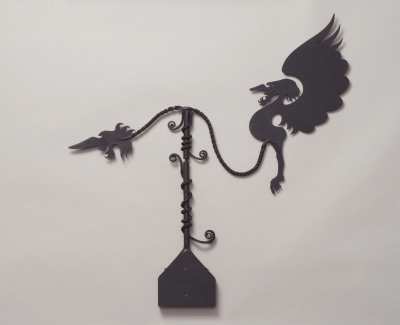L. Brent Kington: Mythic Metalsmith
Exploring Blacksmithing
While in New York City at the first World Crafts Council meeting in 1964, Kington visited the Arms and Armor section of the Metropolitan Museum of Art. He was so impressed by the metal and iron work that he began imagining new possibilities for his own work, particularly working in a much larger format. In order to do so, Kington needed to learn blacksmithing. Since there were very few books available on blacksmithing at that time, Kington sought out the few local blacksmiths still working in the Carbondale, Illinois, area. He found the Deal brothers, Ben and Jim, in Murphysboro, Illinois, one of whom was trained at Tuskegee University, and an elderly, retired blacksmith. He learned from them how to build a fire and control the heat, and how to work with the material.
For five years beginning 1964, Kington developed his blacksmithing skills and expanded the shop area of the Metals Program at SIUC. Kington took a local trade school welding course and learned how to arc weld. He also built a blacksmith shop at his home. In 1969, Kington decided to stop working in small scale precious metals as a metalsmith and instead commit to working in ferrous metals and creating larger work as a blacksmith.
In Mythic Metalsmith, four pieces in particular represent Kington's transitional work into blacksmithing. The large Air Machine, 1968, (not shown) hand-forged in iron and steel, is a reinterpretation of his earlier cast silver air machines. This piece was selected by New York City gallery owner Lee Nordness and purchased by S. C. Johnson for the now epic 1969 traveling exhibition Objects, USA. At the end of the traveling exhibition, it was gifted to one of the host sites of Objects USA, the Sheldon Gallery at the University of Nebraska at Lincoln.
Untitled, 1968 (not shown) is the first abstract forged iron sculpture Kington created. It has rusted from continued exposure to weather. Kington, who has moved it around his landscape for forty years, has become increasingly sentimental about it.
Gabriel Weathervane 1970, is one of the first in a series of weathervanes Kington created. It was inspired by the early American weathervanes Kington saw at the American Folk Art Museum in New York City. He painted many of his weathervanes, taking the opportunity to further develop unique surface finishes. He also used the “pin in a pipe” technique to create the rotation for movement.
Untitled, 1971 (forged steel) is the earliest kinetic piece in the exhibition that features Kington's fulcrum point mechanism to produce movement. With this mechanism, he places the point of one element into a small indentation of a second element. He then learned to drop the weight below the center of gravity for the full roll, pitch and yaw rotation.
With Weathervane, 1975, Kington used COR-TEN™, a fairly new steel alloy at the time. It was developed to limit the need for painting the surface and instead formed a stable rust-like appearance.
Kington continued developing the roll, pitch and yaw weathervane series, which echoed the growing kinetic sculpture movement of the 1970s. This movement included artists like Alexander Calder and George Rickey. Larger weathervanes created in the late 1970s incorporated a sun and a moon in proportional disk-like shapes, balanced on either end of the horizontal arm, and finished in a black graphite, low sheen surface. One such weathervane, Weathervane #11, 1979, is in the collection of the Illinois State Museum.
During the 1970s exploration period, Kington's students at SIUC — Daryl Meiers, James Wallace, and Bob Griffith — pursued their own enormously successful research, learning to develop and create Damascus or patterned steel. Another group of students developed methods for producing Mokume Gane, a Japanese inspired process of laminating mixed metals with distinctive layering patterns.




